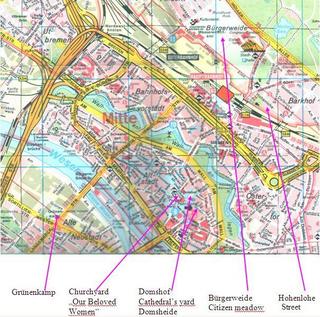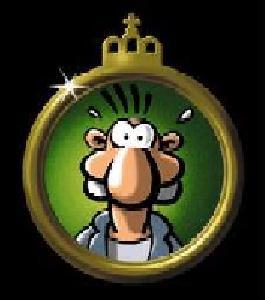Mittwoch, Oktober 19, 2005
The oldest celebration in Germany
Purchase Intoxication and Play-rubbed: The History Of The Bremen Free Market
At beginning was … the “free market economy”!

When it becomes dark outside and uncomfortable, the Bremen people look forward to the “5th season”, which sells all blue thoughts with multicoloured lights, wonderful smells and merry music: “It’s Free Market!” it means in the autumn. The roots of the Bremen free market lie in the Middle Ages. The oldest German people celebration began on October 16th, 1035, when emperor Konrad II. lent the fair justice to the Bremen archbishop Bezelin. Since this memorable autumn day the city had permission for holding market twice a year on the churchyard “Our Beloved Women”. Without each restriction and consideration to the native guilds, Kramer and moving people could sell their goods now – a newly won economical independence, of which still today the name "free market" reminds.
From 1035 on each following emperor renewed the fair privilege regularly. Franz II. was the latter who gave this permission to the Bremen merchants in 1793. Afterwards the Hanseatic people decided themselves, whether and when they wanted to hold market. And they actually wanted always.
From merchandise market to funfair
At the beginning, most of all shopkeepers and moving people went to the Free Market with their goods. They made special sales volume in fall in harvest time, when many farmers came into the city to make their purchases for the winter.
With the introduction of the driving people into the market live became exciting multicolored. Gambler, magicians, fortune teller, clowns and market shouters offered an amazing world of superlatives: the finest cloth, the noblest spices, the sturdiest jokes – and of course the latest gossip from the world out of the borders of the city and the country.
For a few ten-pfennig pieces one could smell the fragrance of adventure and the world. A lion in the high north? In 1445 it already was on the Bremen market place to be admired. More and more exotic animals were added since the 17th century: trained bears, dromedaries and monkeys, up to the first carnivore cage brought by the entrepreneur Amigoni in 1810. From the 17th to 19th century the humans in their whole skurrilitaet were popular exhibition objects: on the free market gave a guest performance with others the “Hottentott” from Africa (1687), the 68 cm “small Mademoiselle” (1799), which was delivered in a small box when desired, “Buffalo Bills Wild West Company” (1890) and the “lion human being Lionel” with hairs all over his body (1938).
Despite driving people the free market remained nearly 800 years long a produce market. Only since the beginning of the last century the picture changed itself to what we understand today by "fair": with huts, tents and roundabouts developed a celebration of the joy and the pleasure developed. 1809 the first showman with a roundabout appeared. The public was inspired by the wooden horses, which turned, from people strength propelled, in the circle.

Most of all the free market went through a large upswing after the first railroads opened from the middle of the 19th century with always new attractions: 1847 inspired "strike to the Lukas" above all the workers, the lyra box men ensured starting from 1870 for tendency, the ship roundabout swung since 1881 at the place and on the driving downhill and mountain starting from 1890 young humans met. Particularly the youth liked the funfair, because during the whole free market time the afternoon lessons were cancelled completely until 1875.
The market surface increased in the course of time and extended from the cathedral yard and the town hall square as far as the railroad station yard, into the Remberti-quarter (1862), Hohenlohestreet (1889). By the compression of the land development in the historical city center of Bremen, the places for the free market became constantly less, so that the free market grew over the tar yard into the new city (1890).
More and more the new city (Gruenenkamp, Hohentor) became the center of the free market. Up to the year 1933 the free market took place alone in the new city and moved to the Citizen meadow in 1934. Since 1934 the free market takes place on the Citizen meadow, in the heart of the city.
In the 19th century huts with honey cakes and sugar candies became more and more popular. The famous lard cake was available since 1847. And another half century later the fish huts with the popular bacon eels got competition: 1906 the Bremen butcher master Wilhelm Keunecke roasted the first fried sausage on open fire.
When the second world war broke off in 1939, the funfair was allowed only once – as a village of huts on the cathedral yard. Fifty-one years ago the showmen invited to the first, still provisional “peace-“free market.
Free market today: further, higher, more beautiful!

Meanwhile the free market ranks among the most popular and most modern people celebrations in Germany. More than four million visitors from close and far the city can register each year. On a surface of 100.000 square meters 350 showmen offer funfair pleasure of superlative: The newest estimate roundabouts promise the ultimative kick. On no other celebration in Germany you’ll find as many roundabouts as on the Bremen free market. The legal closing times are cancelled during the whole 17 days. sugar candies and smoked eel, colourful light cascades and the ultimative kick, party-tumble and play-rubbed: The “cool Bremen” is in state of emergency: “It’s free market!”

At beginning was … the “free market economy”!

When it becomes dark outside and uncomfortable, the Bremen people look forward to the “5th season”, which sells all blue thoughts with multicoloured lights, wonderful smells and merry music: “It’s Free Market!” it means in the autumn. The roots of the Bremen free market lie in the Middle Ages. The oldest German people celebration began on October 16th, 1035, when emperor Konrad II. lent the fair justice to the Bremen archbishop Bezelin. Since this memorable autumn day the city had permission for holding market twice a year on the churchyard “Our Beloved Women”. Without each restriction and consideration to the native guilds, Kramer and moving people could sell their goods now – a newly won economical independence, of which still today the name "free market" reminds.
From 1035 on each following emperor renewed the fair privilege regularly. Franz II. was the latter who gave this permission to the Bremen merchants in 1793. Afterwards the Hanseatic people decided themselves, whether and when they wanted to hold market. And they actually wanted always.
From merchandise market to funfair
At the beginning, most of all shopkeepers and moving people went to the Free Market with their goods. They made special sales volume in fall in harvest time, when many farmers came into the city to make their purchases for the winter.
With the introduction of the driving people into the market live became exciting multicolored. Gambler, magicians, fortune teller, clowns and market shouters offered an amazing world of superlatives: the finest cloth, the noblest spices, the sturdiest jokes – and of course the latest gossip from the world out of the borders of the city and the country.
For a few ten-pfennig pieces one could smell the fragrance of adventure and the world. A lion in the high north? In 1445 it already was on the Bremen market place to be admired. More and more exotic animals were added since the 17th century: trained bears, dromedaries and monkeys, up to the first carnivore cage brought by the entrepreneur Amigoni in 1810. From the 17th to 19th century the humans in their whole skurrilitaet were popular exhibition objects: on the free market gave a guest performance with others the “Hottentott” from Africa (1687), the 68 cm “small Mademoiselle” (1799), which was delivered in a small box when desired, “Buffalo Bills Wild West Company” (1890) and the “lion human being Lionel” with hairs all over his body (1938).
Despite driving people the free market remained nearly 800 years long a produce market. Only since the beginning of the last century the picture changed itself to what we understand today by "fair": with huts, tents and roundabouts developed a celebration of the joy and the pleasure developed. 1809 the first showman with a roundabout appeared. The public was inspired by the wooden horses, which turned, from people strength propelled, in the circle.

Most of all the free market went through a large upswing after the first railroads opened from the middle of the 19th century with always new attractions: 1847 inspired "strike to the Lukas" above all the workers, the lyra box men ensured starting from 1870 for tendency, the ship roundabout swung since 1881 at the place and on the driving downhill and mountain starting from 1890 young humans met. Particularly the youth liked the funfair, because during the whole free market time the afternoon lessons were cancelled completely until 1875.
The market surface increased in the course of time and extended from the cathedral yard and the town hall square as far as the railroad station yard, into the Remberti-quarter (1862), Hohenlohestreet (1889). By the compression of the land development in the historical city center of Bremen, the places for the free market became constantly less, so that the free market grew over the tar yard into the new city (1890).
More and more the new city (Gruenenkamp, Hohentor) became the center of the free market. Up to the year 1933 the free market took place alone in the new city and moved to the Citizen meadow in 1934. Since 1934 the free market takes place on the Citizen meadow, in the heart of the city.
In the 19th century huts with honey cakes and sugar candies became more and more popular. The famous lard cake was available since 1847. And another half century later the fish huts with the popular bacon eels got competition: 1906 the Bremen butcher master Wilhelm Keunecke roasted the first fried sausage on open fire.
When the second world war broke off in 1939, the funfair was allowed only once – as a village of huts on the cathedral yard. Fifty-one years ago the showmen invited to the first, still provisional “peace-“free market.
Free market today: further, higher, more beautiful!

Meanwhile the free market ranks among the most popular and most modern people celebrations in Germany. More than four million visitors from close and far the city can register each year. On a surface of 100.000 square meters 350 showmen offer funfair pleasure of superlative: The newest estimate roundabouts promise the ultimative kick. On no other celebration in Germany you’ll find as many roundabouts as on the Bremen free market. The legal closing times are cancelled during the whole 17 days. sugar candies and smoked eel, colourful light cascades and the ultimative kick, party-tumble and play-rubbed: The “cool Bremen” is in state of emergency: “It’s free market!”

